The British total of killed and wounded was very evenly distributed throughout the fleet. Only the rear ship lost an important spar,—the main topmast. It was upon her, as already mentioned, and upon the two leading ships, the Exeter and Isis, that fell the heaviest fire, proportionately, of the French. From the position of the seven van ships of the latter, such fire as they could make must needs be upon the extreme British van, and the Exeter was forced to leave the line. The loss of the French that day was 82 killed and 255 wounded; of which 64 killed and 178 wounded belonged to the Heros, Illustre, and Ajax. The British had 51 killed and 283 wounded; the greatest number of casualties in one ship being 56. Singularly enough, in such a small list of deaths, three were commanding officers: Captains Watt of the Sultan, Wood of the Worcester, and Lumley of the Isis.
At 5.30 P.M. the wind shifted suddenly from south-west to east-south-east (C). The British wore together, formed on the other tack, and continued the fight. It was during this final act, and at 6 P.M., that the mainmast of the French flagship came down. The van ships of the French had towed their heads round with boats before 4, in order to come to the support of the centre, in obedience to a signal from Suffren; but the light airs and calms had retarded them. With the shift they approached, and passed in column (c) between their crippled vessels and the enemy. This manoeuvre, and the failure of daylight, brought the battle to an end. According to Hughes’s report, several of his fleet “were making much water from shot-holes so very low down in the bottom as not to be come at to be effectually stopped; and the whole had suffered severely in their masts and rigging.” Trincomalee being in the enemy’s possession, and the east coast of Ceylon an unsafe anchorage now, at the change of the monsoon, he felt compelled to return to Madras, where he anchored on the 9th of September. Suffren regained Trincomalee on the 7th of the month, but the Orient, 74, running ashore at the entrance and being lost, he remained outside until the 17th, saving material from the wreck.
The break-up of the south-west monsoon, then at hand, is apt to be accompanied by violent hurricanes, and is succeeded by the north-east monsoon, during which the east coasts of the peninsula and of Ceylon give a lee shore, with heavy surf. Naval operations, therefore, were suspended for the winter. During that season Trincomalee is the only secure port. Deprived of it, Hughes determined to go to Bombay, and for that purpose left Madras on the 17th of October. Four days later a reinforcement of five ships of the line arrived from England, under Commodore Sir Richard Bickerton, who at once followed the Commander-in-Chief to the west coast. In the course of December the entire British force was united at Bombay.




